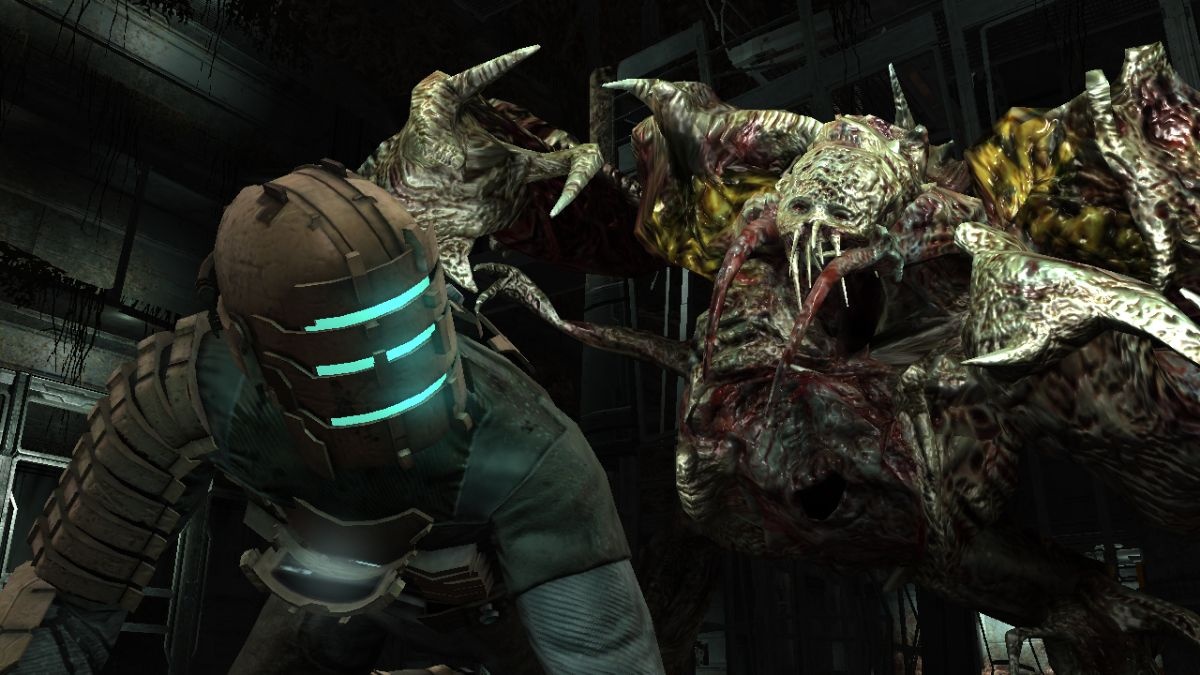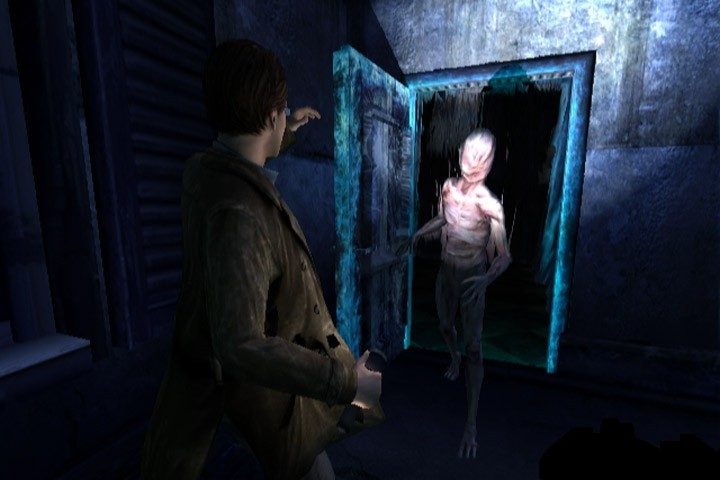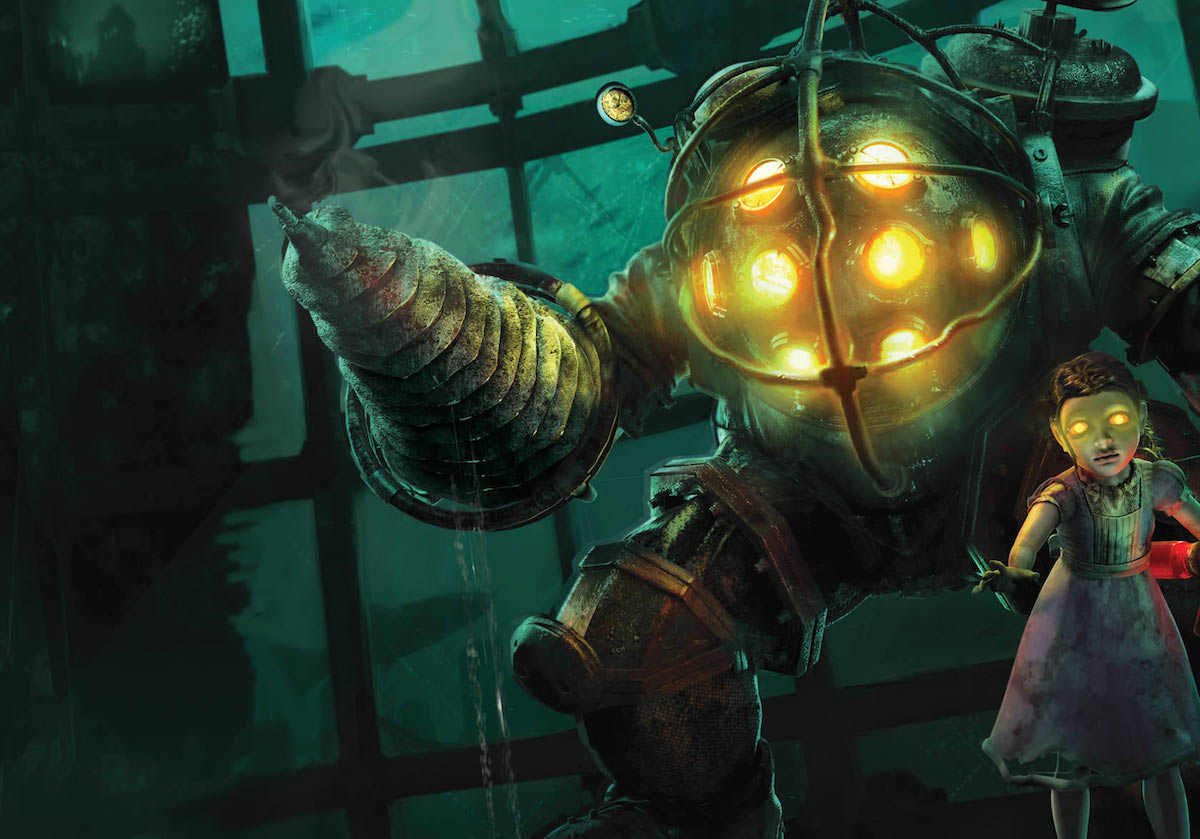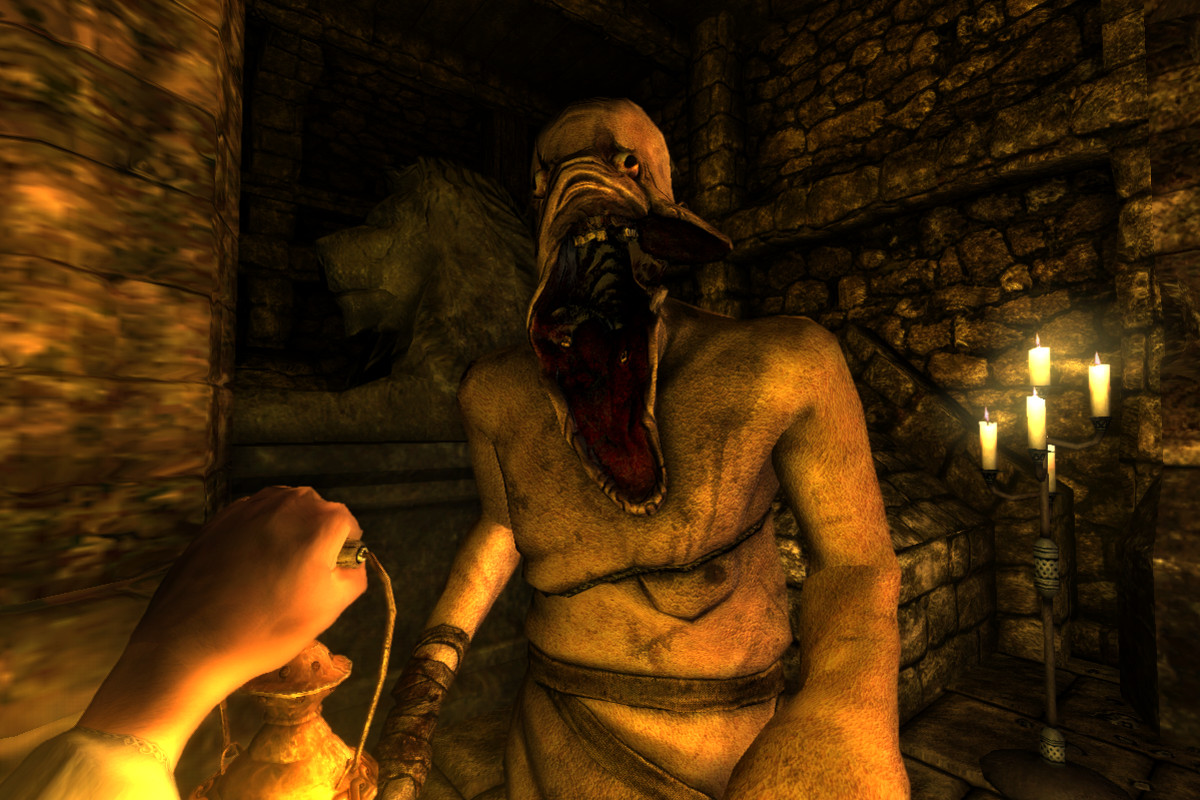Silent Hill, Resident Evil, and the Art of Making Scary Games
Some of gaming's greatest horror minds talk about the challenges of designing truly scary games such as Silent Hill and Dead Space..
Horror may be a centuries-old genre, but horror game developers have faced challenges that Mary Shelley, Stephen King, and John Carpenter never had to. They’ve battled the idea that games are meant to be simple fun while learning how to turn code into nightmares.
How did they do it? We asked that question to some of the creators responsible for gaming’s greatest horror experiences. Here’s what they have to say about making scary games.

Wright Bagwell
Designer of Dead Space, Director of Dead Space 2 at Visceral Games
“Scaring the shit out of the player was definitely the goal [with Dead Space],” Wright Bagwell recalls. “I remember [Dead Space creator and executive producer] Glen Schofield saying that he wanted to build the scariest game of all time.”
At that time, building the scariest game of all-time meant besting the current genre king, Resident Evil 4. Indeed, the Dead Space team initially referred to their project as “Resident Evil 4 in space.” It was a bankable pitch, but the team struggled when it came to balancing the action of a game like Resident Evil 4 with their goal of designing the scariest game ever made.
“Some of [the team] were like, ‘You can’t make a scary game if you let the player move and shoot,’” Bagwell says. “What they realized is that you don’t have to have these clunky control schemes in order to scare the player. You can do that through audio and lighting and level design and enemy design.”
While the Dead Space team was against crippling the player with awkward controls, Bagwell says that it was important to ensure the player didn’t feel like “James Bond.” Accomplishing that meant depriving them of fundamental resources and general confidence.
“We said, ‘You need to feel like you’re desperate for health and for bullets all of the time,” Bagwell says. “We let you move and shoot and all these things…[but] to counter that, we made very dark, claustrophobic environments.”
When it came time to develop Dead Space 2, Bagwell and the rest of the team even went so far as to develop a system that measured how many resources the player had when they reached the game’s various checkpoints. By forcing the player to constantly scrounge for resources, the team also ensured that the player couldn’t hide from a level’s darkest corners.
“You kind of walk into every situation feeling like, ‘God, I don’t have everything I need to win whatever fight I think might be coming,’” Bagwell says. “So I’m going to be cautious and I’m going to scout every inch of this level to try to find a bullet, power node upgrade, health upgrade, etc.”
Of course, even the most desperate of players need something to be scared of. Fortunately, the Dead Space franchise wasn’t lacking in intimidating enemies. From Necromorphs that had a habit of playing possum in order to instill a sense of false security to Stalkers whose basic design was inspired by the velociraptors in Jurassic Park, Dead Space’s various nightmares had a habit of attacking you in ways you aren’t prepared for. Even the game’s save rooms harbor jump scares.
Related Article: The Twisted Grindhouse Legacy of Manhunt
Yet, Bagwell says that the original versions of Dead Space featured “about four times as many enemies and jump scares” as the final product. Many of those enemies and scares were cut when the team began to seriously examine the value of restraint.
“As we developed every level, what we found is that less is more,” Bagwell says. “Sometimes the best experience is when nothing happens. It constantly raises the tension where you’re like, ‘Okay, nothing happened, something big is probably coming, oh god, it’s gonna be big.’”
Ironically, the team wasn’t prepared for Dead Space 2’s biggest scare: The infamous NoonTech Diagnostic sequence. Bagwell recalls watching the gruesome death scene triggered when the player failed to properly insert a needle in the hero’s eye.
“You get into this machine and now you just have to aim this needle at your eye and then poke it,” says Bagwell. “I was so proud of it because when you make games, even the most surprising or entertaining thing that you put in you end up having to play it and watch it just thousands of times…inevitably at the end of the development cycle for most games you’re like, ‘Ugh, okay. I’ve played this so many times.’ It just doesn’t really entertain you that much as one of the developers.”
However, Bagwell says that the final time watching the NoonTech Diagnostic sequence was just as intimidating as the first.
“We turned off the lights and watched it for the final time. There was this feeling of, ‘Oh, God. This is horrible.’ But like, ‘Yes. This is so awesome. This is going to be great’ … It was the only thing I’ve ever done where I was not numb to it by the end of the development cycle.”
Following the closure of Dead Space developer Visceral Games in 2017, and the apparent death of the franchise, Bagwell also wonders if it’s too much to ask people to spend “10 to 15 hours feeling like [they’re] going to have a heart attack.”
“I just think that there’s a smaller number of people who want to experience that,” Bagwell says. “If I was trying to create a game that sold as well as possible, I wouldn’t think that scaring people to death would be the best way.”

Sam Barlow
Writer and Designer of Silent Hill: Origins and Silent Hill: Shattered Memories at Climax Studios
“[With] suspense…you’re trying to give the audience enough information that they can put it together in their head and be dreading something happening,” Sam Barlow says. “There’s a special tool set in video games where you’re really doing that.”
With Silent Hill: Shattered Memories and Silent Hill: Origins, Barlow wanted to return to Silent Hill’s roots. Mechanically, that meant ensuring that the titles emphasized exploration and puzzle solving over action. What it really meant, though, was creating a world of psychological horror unique to gaming.
“If you want to tell a story that’s all about someone’s inner monologue, then go write a book,” Barlow says. “I think psychological horror gets to have its cake and eat it by allowing that character’s state of mind to bleed into visualness.”
In Shattered Memories, the player’s state of mind manifested itself through choices. The game created a psychological profile for each player that is most obviously furthered by sections featuring a psychologist. Dr. Kaufmann asks you basic psych profile questions (such as “How easily do you make friends?”) as well as more complicated conundrums such as how you would determine the guilt of various characters in a story. All of these sections will impact the events of the game in some way based on how you shape your own mental state.
However, Shattered Memories doesn’t always rely on the player to be honest about their own mindset. The game also examines the in-game actions of every player and uses them to shape the rest of their adventure in ways they may not realize. Focus on sleazy posters and characters you meet become more sexualized. Linger on bottles of booze too long and you will be regarded as an alcoholic. Why would developers go to such incredible trouble to just alter a few in-game details? It’s because they were trying to create a story that felt unique to the medium of gaming.
“We made you deeply feel their story, the way in which you had projected [your thoughts] on to your protagonist,” Barlow says. “It’s very hard to untangle the interactivity from the experience of [that story].”
Related Article: Exploring the Terror of P.T., the Silent Hills Demo
Interactivity may have helped Shattered Memories’ story, but it proved to be a bit of a burden when it came time to design the game’s action sequences. Just as the developers weren’t interested in telling a story that felt standard, they also weren’t interested in making another game where you shot your problems away. To that end, Climax Studios decided to utilize the kind of “action” that we typically see in slasher films.
“The action element was running, it was being scared,” Barlow says. “Fight or flight is kicking in, you’re anticipating something bad happening. … Your imagination is now doing all the work and it’s terrifying.”
That style of action complemented the story, but it wasn’t what executives had in mind. Because Shattered Memories launched as a Nintendo Wii game, they wanted it to utilize the popular motion control schemes of the time. Their ideas didn’t necessarily mesh with the ambitions of the game’s design team.
“Everyone told us ‘We should be swinging rusty pipes using a Wiimote and aiming guns with a Wiimote,’” Barlow says. “We went ‘It’s fine! It’s fine. Why not be ambitious?’”
The game’s most ambitious aspect was the ending. The player’s psychological profile contributed to the details of the ending in subtle, significant, ways. Each ending catered to their subconscious, but that degree of variance meant no detail could be overlooked.
“Every scene of the game contain[ed] the DNA of that ending,” Barlow says. “When an artist dressed an area, he was trying to touch on those pieces of imagery. When a puzzle designer was coming up with an interactive moment, they were trying to establish some metaphors or set up some actions. … That whole game is soaked with a deliberate repetition of imagery and ideas so that when we get to that ending, it lands as hard it can.”

Bill Gardner
Designer on BioShock at Irrational Games, Director of Perception at The Deep End Games
“Listen, I love horror. I grew up with horror,” Bill Gardner says. “My parents owned a video store when I was growing up so you name it, I’ve seen it.”
Gardner may have been a horror film fan, but when it came to game design, he soon discovered that not all horror film concepts translate across multiple mediums. This is especially true of an infamous sequence near the beginning of BioShock when the player encounters a Big Daddy for the first time. The sequence only really works if the player is intently watching a Big Daddy destroy one of the game’s splicers (human scroungers) through the other side of a window.
However, Gardner became annoyed by testers’ ability to “run in the corner and put their head down” while the sequence was playing out. In doing so, they were able to hide from the event that established the underlying horror of BioShock. Frustrated, he asked BioShock director Ken Levine if they could manipulate the camera and take control away from the player just this once. Levine told him something that would become the basis of BioShock’s approach to video game horror.
“[He said,] ‘The second you do that, the director, the creators, the designers, they’re putting their hand on the player’s shoulder and saying, ‘It’s okay. You’re gonna be safe.’ You can’t be hurt here and that’s what a cutscene really is.”
BioShock used interactive cutscenes to tell a meta-story about how gamers are never really in control. Instead, players are subject to the machinations of the storytellers, as the protagonist falls deeper into a routine of command and compliance. It’s a narrative experience that showed Gardner the difference between a horror game and a truly scary game.
“A horror game where there are waves of [zombies], it’s like ‘Okay, this is more fun than scary,’” Gardner says. “In the context of a game…I’m much more interested in sequences where it’s one zombie and I get the backstory.”
Related Article: How Resident Evil 4 Influenced BioShock
With Perception, Gardner tried to translate that intimate brand of fear into a digital experience. The story of a blind girl stuck in a haunted home, Perception forced players to empathize with the protagonist’s disability. Indeed, Perception is designed to ensure that the player is blind to much of what is happening.
“I’m most interested in creating an atmosphere of dread, and that feeling of what’s around the next corner,” said Barlow. “ Is someone there? That sort of paranoia, that dread…Most horror is about veiling things in mystery and misdirection, and lack of information.”
While that is indeed true of most horror, there are times when it can be handy to not only give gamers something to latch onto in a horror game but to understand what makes that relationship between the gamer and the game so important. Indeed, Gardner believes that great horror gaming should utilize the connections the player establishes.
“There’s a thing that connects with gamers in the back of their head, and they’re like, ‘This could be me,’” Gardner says. “When you look at BioShock, the way that Ken and the team designed [the games], you look at the things that [the players are] tormented with, and they’re the echoes of [the protagonist’s] personality and their former life.”

Thomas Grip
Designer on Amnesia: The Dark Descent, Director of SOMA at Frictional Games
“SOMA, Amnesia, Penumbra, most of the horror there is fairly cozy,” says Thomas Grip, who likes to make players feel comfortable before introducing the horror. “You just add an extra layer [and it goes] from being cozy to being a horror environment.”
Fans of Grip’s horror games probably wouldn’t describe them as cozy, though. His titles create thick horror atmosphere through sound and shadow. They throw players into dark areas and force them to endure the implied – and often overt – presence of nightmarish monsters. His games are a masterclass in creating atmosphere through graphics and sound. However, Grip believes truly effective horror atmosphere is about more than audio and visuals.
“Atmosphere is not just some vague essence. It’s not like a perfume…even though it might feel like that for a player, they like to soak in the atmosphere,” Grip says. “It’s more about the scenario that you’re building up with a player.”
In Amnesia, that scenario includes the presence of a sanity system. If the player spends too much time in the shadows hiding from enemies or is forced to witness horrific events, the sanity of their character may drop. This can cause their character to suffer blurry vision, see enemies that really aren’t’ there, and even pass out. It’s a terrific way to “gamify” Lovecraftian themes of sanity and horror.
However, sanity is more than a just game mechanic in Amnesia. Grip and his team also attempted to account for the general sanity of the player when designing Amnesia’s key sequences. Grip elaborates on that idea by highlighting his favorite scene from Amnesia, a revolutionary horror experience that helped kick off a new era of pure horror gaming.
“[You’re] looking for certain items and suddenly you hear [a monster],” Grip says. “You go into the closet…the monster is going to go inspect the closet…you’re thinking, ‘Should I make a run for it? What’s my best course of action?’ … We made what was basically a [cutscene] but we managed to do it in gameplay.”
Said gameplay includes the use of a first-person perspective. While Amnesia wasn’t the first first-person horror game, its use of that viewpoint was seen as a revolutionary moment in the history of horror design. Few other games up until that point had used the first-person perspective in this overt way that took information away from the player. While Grip says that the use of first-person gameplay was partially based on design preferences, it was also implemented because it made things easier.
“[With first-person] you can mimic movements that people do in horror movies. So, for example, just looking behind a corner, peeking through doors, those moments are way harder to do in a third person mode…from my end I think the controls are tighter in a first-person game,” says Grip. “Also doing it from first-person meant that you didn’t have to render any character models so you’re like, okay, you can skip the hardest part in the making of a game. That was nice.”
If first-person gameplay broke some horror trends of the era, then Amnesia’s complete lack of combat absolutely shattered genre conventions. When it comes to combat in horror games, Grip simply feels that it affords the player too much safety.
“Games tell you through the combat system what the default manner of dealing with the dangers are,” Grip says. “[If the] game doesn’t tell you at all how to deal with it…it’s much harder for the player to feel secure.”
While Amnesia doesn’t offer you any real defensive options, that doesn’t mean that the game is trying to deprive you of all resources. In fact, Amnesia is one of the best horror games out there in terms of utilizing a clear series of rules regarding horror encounters. Part of Grip’s desire to adhere to clear rules is based on his preferences in horror films.
“The thing is that I think what made the film [Nightmare on] Elm Street good is that it’s consistent,” says Grip. “Even though Freddy Krueger is anything can happen in our dreams, but it always happens in the dreams, right? So there’s this certain terror about, ‘Oh no, someone is falling asleep. Oh no, what shit is going to happen to them?’ Whereas in [2017’s] It, there’s no consistency to the clown scares…There’s no formula for it, so it gets harder for you to get engaged in it.”
To that end, Grip ensured that Amnesia employed a clear series of rules regarding how its scariest moments work.
“In Amnesia…the monsters make a sound before you even see them,” Grip says. “You can have encounters with monsters where the players never sees the monsters, they just hear the music and perhaps some footsteps…Then the player wonders, “Where the hell did the monster go?” And, that works very successfully.”
Perhaps constant panic isn’t as “fun” as a jump scare, but Grip isn’t sure whether fun is what keeps people glued to horror or makes horror effective.
“‘Fun’ is a sort of tricky word to use. I think ‘engagement’ is better,” Grip says. “As long as you can wrap it up in some sort of engaging structure, the sky’s the limit in how much you want to terrorize your audience.”
Matthew Byrd is a staff writer for Den of Geek. He spends most of his days trying to pitch deep-dive analytical pieces about Killer Klowns From Outer Space to an increasingly perturbed series of editors. You can read more of his work here or find him on Twitter at @SilverTuna014.
